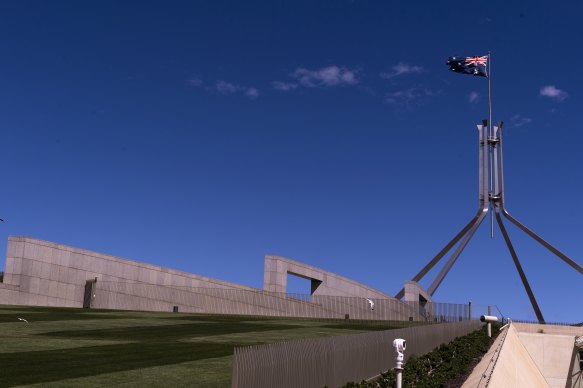By Tony Wright
Those suspicious about the trajectory of Australian democracy might need no convincing, but now the very symbol of the nation has been shredding before our eyes.
Oh, dear.

How did the poor thing reach such a despondent state that it would barely be out of place on the yardarm of a ship emerging from a hurricane?Credit: Rhett Wyman
The massive flag that flies 24 hours of every day above Parliament House, background to a thousand televised gusts of political commentary, has become a tattered thing, torn and holed and woebegone.
Has our economy, ripped by inflation and assaulted by the Reserve Bank, come to this, that we can no longer afford to replace our distressed flag?
And how did the poor thing reach such a despondent state that it would barely be out of place on the yardarm of a ship emerging from a hurricane?
Winds of change? Cyclones of hot air blustering from the chambers below?
It took two of the most powerful figures in Parliament House, Speaker Milton Dick and Senate President Sue Lines, to offer on Wednesday an official mea culpa and explication about what they described as the flag’s “unacceptable condition”.
And within 24 hours, they were promising the flag would be removed in the next two days, and the fiasco wouldn’t reoccur.
Their initial statement followed Liberal flag-waver Dan Tehan raising the national standard’s sorry state, suggesting it failed the expectation that Australians should “have pride in our parliament and pride in our flag”.
Dick and Lines blamed high winds and thunderstorms over Canberra, combined with a failure of the mechanism used to transport workers up the giant flagpole.
“Changing the flag is a dangerous and complex undertaking due to the sheer size of the flag and the high wind conditions at that elevation,” they said in a joint statement.
“When there was an opportunity for staff to safely ascend the pole, the lift mechanism experienced a mechanical fault.”
The Anzacs, surely, would have scaled the heights and rescued the flag without a second thought.
Dick wasn’t happy about making excuses. By Thursday, there had pretty clearly been tough words behind the scenes.
“I am pleased to advise the process has been expedited to replace the flag,” he announced to the House.
“Weather permitting, protocols will be put in place to replace the flag within the next two days.”
Furthermore, “alternative options and contingencies” would be prepared to ensure such an event would not happen again.
The flag flies at the dizzying height of 81 metres atop a mast that is among the world’s largest stainless steel structures.
At a mighty 12.6 metres by 6.4 metres, the flag requires wrangling by a team of three workers who ascend the mast in a mechanical trolley when, as is usual, it is changed on the first Wednesday of each month.

The flag flies at the dizzying height of 81 metres.Credit: Rhett Wyman
Parliament House stores around a dozen flags to ensure they wear evenly and that there is always available a national symbol in good repair.
But alas, this piece of cloth has taken such a beating it appears unfixable.
What to do with a hopelessly frayed flag when it is eventually lowered?
There is, naturally, a protocol laid out in detail in a document entitled the Australian Flag Booklet issued by the Australian government.
And there, under the bleak heading “Disposal of flags” is the following directive:
“When a flag becomes dilapidated and no longer suitable for use, it should be destroyed privately and in a dignified way. For example, it may be cut into small unrecognisable pieces, placed in an appropriate sealed bag or closed container then disposed of with the normal rubbish collection.”
What a miserable destiny for a national symbol that has battled gales, thunderstorms and blasts of hot air while bravely awaiting rescue from a parliamentary system that refused to run up the flagpole.
Cut through the noise of federal politics with news, views and expert analysis from Jacqueline Maley. Subscribers can sign up to our weekly Inside Politics newsletter here.